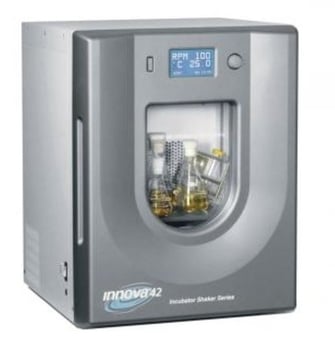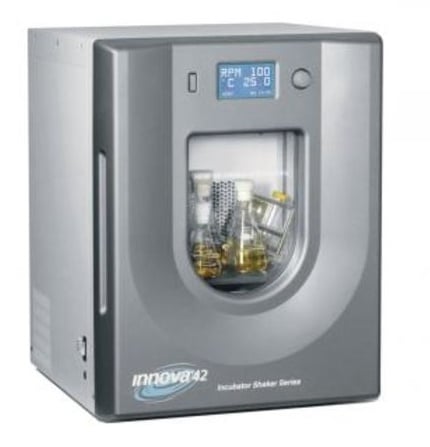Incubators, in the simplest terms are heated boxes that keep samples at a constant temperature. They vary widely in their design, but there are 3 basic features you should pay special attention to when choosing a model. The size of an incubator, whether it shakes and if it can create a CO2 atmosphere. These 3 features largely determine what can be grown and how much of it can be grown at a time. They also largely determine the cost and flexibility of a unit.
There are other features to consider as well, e.g. sensor placement, heating element style, insulation, temperature uniformity etc. While important, these points are more useful when choosing between models of the same class once you have a general idea of what you need.
That said, let’s get into it with a few examples.
Size
The first thing you should consider is how big you need your model to be. Incubators vary widely in size, from small benchtop models to large industrial scale floor models. They are sized by internal volume, written in either cubic feet or Liters. In general, smaller units cost less to own and operate while larger units cost more. Larger units also tend to have more features, e.g. refrigeration, photosynthetic lamps, multiple shaker platforms etc. that offer more operating flexibility. For these reasons, it is important to choose the volume that works best for your needs.
One of the smallest units we sell is this 20L one by Benchmark. It is very small and easily fits on a benchtop. It’s ideal for incubating small amounts of reagents, ELISA plates, petri dishes etc. It doesn’t offer CO2 control or shaking which makes it unsuitable for most cell culture operations. These inexpensive models are best for personal use, teaching labs or anywhere you need a small incubator e.g. a tissue culture room.
The next size up are these 80L and 170L models by Labnet. They are much larger, still they can fit on a benchtop or under a counter. These can fit several stacks of plates or dishes, multiple 2L bottles etc. Still no shaking or CO2 so best for bacterial culture and sealed tissue flasks. Best for medium sized labs with multiple users.

On the largest end are floor models like this Eppendorf Inova 42, this one has a 380L volume. It has all the bells and whistles. Built in UV germicidal lamp, a 12-channel gas manifold and a heavy duty shaking platform. You can grow most organisms in these units, as they control for motion, CO2, temperature and humidity across a wide range of values. That said, these are massive. They weigh 400 pounds and have a price to match. These are best used by bigger labs and industrial operations that need the ability to grow large samples e.g. multiple 5L flasks of suspended cells.
Shaking Incubators
Another important feature to consider is whether an incubator shakes or not. If you plan on growing suspended samples e.g. bacteria, yeast, non-adherent cell strains shaking is a must. Shaking platforms are available in a range of models from small benchtop to large floor models. In general, the more expensive models have more durable motors and can shake at higher speeds which are described in rotations per minute (RPM).
This mini shaking incubator by Benchmark is a good place to start. It offers temperature control and shaking allowing the user to grow or incubate a few plates or tubes at a time. They are convenient for personal use and teaching labs.
The next largest model by Benchmark is 20L and will shake several 500mL flasks at once. It’s ideal for most medium sized labs that need to grow no more than a few liters of cells at a time.
Up from here there are large stackable and floor models that offer shaking. The Eppendorf 44 model is stackable model that can fit several 5L bottles. These are best for larger labs and industrial use where multiple liters of cells need to be grown at a time. These larger models offer many features, e.g. refrigeration, humidity control, germicidal lamps etc.
CO2 Incubators
The last major feature to consider is the ability of an incubator to create an artificial atmosphere. If you are growing a cell line from a multicellular organism chances are you need a CO2 atmosphere. Most units offer the ability to easily alter the CO2 concentration, usually shown as a percentage of the total atmosphere. Higher end units usually offer more gas manifold ports to improve operating flexibility e.g. one for oxygen, nitrogen and CO2. More expensive units usually also offer shaking for suspended cell line growth.
This mini CO2 incubator by Benchmark is the most affordable CO2 incubator we carry. It’s ideal for culturing small amounts of adherent cell lines. It has a small footprint (20L) and can fit on a benchtop which makes it good for personal use and small teaching labs.
This shaking CO2 incubator by Benchmark is the most affordable CO2 incubator we have that also shakes. It is an affordable option that offers great flexibility. Depending on the atmosphere, shaking setting and temperature you can grow most organisms in this unit. It’s also small (67L) so it fits on either a benchtop or under the counter. Best for personal use up to medium sized labs.
This Eppendorf 170L stackable CO2 incubator is one of the larger models we carry. It’s large size and price tag make it suitable for large labs and industrial use. These have all the features, from internal partition doors and a widely variable atmosphere (.1-19% O2) to an LCD screen and remote data logging.
Hopefully this guide gives you a quick idea of what to look for. Once you have down the size, atmosphere and shaking requirements you need, you can consider more specific features. If you have questions or need help choosing what’s right for you, just give us a call at 800-243-3232 or write to us at info@pipette.com.



